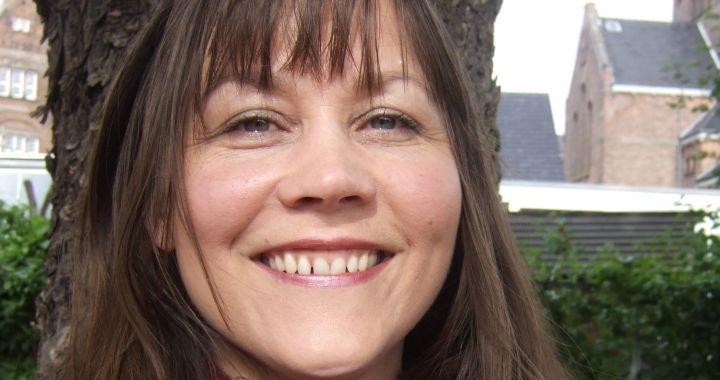
Buying “Outsider” Pieces
An interview with Trine Ross, Danish writer, critic, TV personality and art collector
Jacob Stubbe Østergaard
16/01/2014
The stereotypical art collector could be the villain in a James Bond movie. Very old, well-dressed, infinitely rich, with oversized rooms, stuffed animals of threatened species, butlers to take care of everything and an office full of market analysts evaluating what to buy next. He would store his most important pieces in maximum security vaults. At least one Picasso and at least one van Gogh.
What would be the opposite of that? A woman in her 40's, with an ordinary income, who buys art only out of love. She almost exclusively buys new and daring pieces by young artists, whose ateliers she frequently visits. She stores it all openly on the walls of her apartment because she wants to look at it. She is talkative and laughs easily. This is Denmark's Trine Ross, whom I'm going to interview in a few minutes.
To be fair, she's not just a random person who happened to take up art collecting. She's an art critic for the biggest national newspaper, and she's a TV celebrity too, permanent guest of the Art Quiz, where contestants duel in identifying works of art. She has also written more than 20 art books and interviewed most noteworthy personalities in contemporary art. Because of her work, she gets down and dirty with everything that happens in the art world, and she has a personal relationship with dozens of artists. She's everything the sterile super-rich collector is not.
I meet her in 'her' café. It's on a downbeat Nørrebro street corner, so close to her home she can almost go there in the morning without getting dressed. The room is spacious with walls of stone. It's a stylish hybrid between bakery and café. As I order two cups of coffee to help liven our spirits for their journey into a long and engaging conversation, I stare into the fire of the giant oven behind the counter. As we sit down in the snuggest corner, the pleasant scent of freshly baked bread blends with the scent of coffee and the candle which stands on the wooden table between myself and my interviewee.
She walks in with the sweeping elegance of a cigarette-smoker but no sign of the aloofness. When we start talking, she lights up right from the beginning. And she's generous with her words. I'm not surprised. After all, she makes a living giving lectures on art: ("the Cobra movement", "Danish contemporary art", "Why and how to write about art"...).
It's been 13 years since Ross' love for art began to manifest as a collection of tangible pieces of art. Now every wall in her home is plastered with art to the point that, as she puts it: "People get a bit frightened when they enter our apartment because all the walls are completely plastered. Especially the kind of people who like clear, white walls. I observe them entering a state of shock when they come to our place".
As all lifelong obsessions, it first began when she fell in love. Trine Ross was in her early twenties and the piece was an etching by Danish punk generation artist Knud Odde. She was a penniless art student and for a long time the picture was 'out of her league', so to speak. She paid regular visits to this particular art boutique just to see her beloved picture. When she finally took it home, it was to celebrate her first time being paid for writing an article about art.
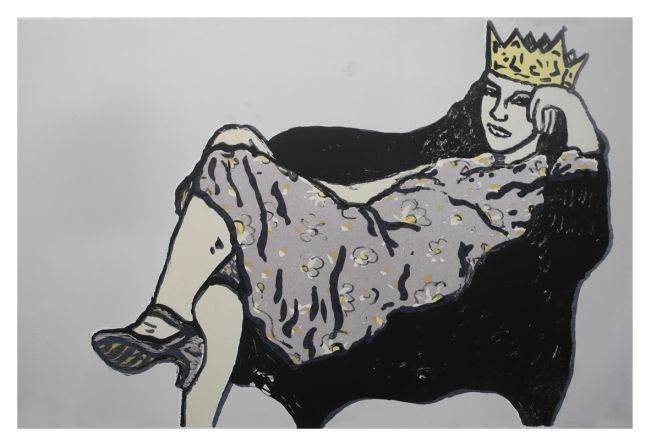
Lithograph by the artist who started Trine Ross collecting art. Knud Odde's Dame i stol (Lady in chair), 2013
I made a deal with myself that if I had made the money on art, I could spend it on art. So I immediately rushed down to buy the picture. And then I brought it home in triumph.
I really fell in love with that picture. It was insurmountable. It took almost 10 years before I fell in love with another work of art. But that was when it started getting out of hand. The change happened when it occurred to me that you could buy works from exhibitions. I had found the Knud Odde etching while leafing through a pile of posters in a shop. An ordinary context for buying something. Going to an exhibition and bringing one of the exhibits home had seemed absurd to me before. You could own art? Really? Doing it for the first time was trippy. I guess that as an art historian, I had always thought of art as common property.
Did it just expand gradually from there?
Well, another factor was my divorce, which happened at that time. Suddenly I had my walls all to myself. I got the chance to ask myself: 'Who am I? What do I like? Where do I really want to go?'. It was a difficult time. People would ask me what I was doing on Wednesday, and I'd be like... 'I'm not doing anything for the rest of my life!'... But it was also a lot of fun. In terms of art collecting, it was nothing but fun. I could finally begin to find out what I really wanted. And it went very fast from there. Suddenly my walls were all filled.
So, you asked yourself: "who am I?", and then you hung the answers to that question on your walls so that you could walk around your home and constantly be reminded: "this is who I am. This is what I stand for."?
I don't think I thought about it like that back then, but now you mention it, I think I unconsciously did feel that way. Furniture and images are what really makes a home. I moved around a lot during that time, but because I brought my works of art, each place immediately became my place.
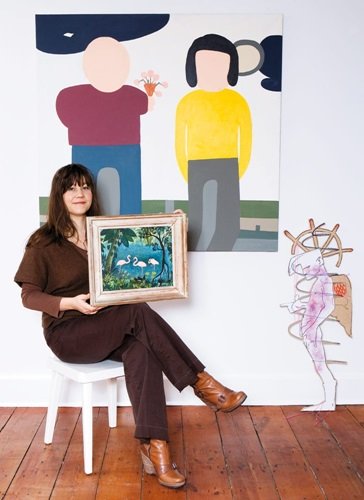
Trine Ross posing with three pieces from her collection. Photo: Anitta Behrendt
Do you have a theme or a kind of personal touch in the art you buy?
Nothing that I take into account when buying pieces. However, I have realized over time that I do have themes. I have a tendency - not just in art, I think - to go for the outsider. I'm taken in by that one piece which sticks out. So I have a lot of pieces which are not typical of their artist.
Take that Knud Odde picture. I only got to talk to Knud Odde many years after I had bought it, but when I told him how I had fallen in love with that picture and saved up to buy it, it turned out that he also had a tender eye for this particular piece. It didn't look like the others. It had been experimental to him. It didn't hold the weight of the other pieces.
[Several times during the interview, it strikes me that when she's talking about her pieces of art, she's as enthusiastic as a parent who's been asked about her kids. At this point, she even makes the comparison herself... - JSØ]
I could imagine that if you had kids, this kind of piece would be the 'misbegotten' one. And Knud Odde was glad, too, that it was in good hands with me, she says of her first loved piece, which she still holds very dear. ...and the same thing has happened to me with other artists as well.
A lot of other collectors would do the opposite of what I do, she continues. They want pieces that immediately reveal who the artist is, so that as soon as people step in, there's the "look what I've got!" effect. Actually I don't quite understand why some larger-scale art collectors are so conservative when they buy. They seem to be more concerned with buying something that's already generally accepted than buying what actually speaks to them. It gets me thinking: "When you've got the money to collect art, why don't you put some personality into it?"
Anyway, with the "outsider" pieces I usually buy, you have to look more carefully to find out who the artist is.
Could you tell me about some of your other favourite pieces from your collection, aside from the Knud Odde one?
It's really decadent, but I have this big portrait my cat - now deceased - painted by Peter Karlsen. It was commissioned by my ex-husband, but we got divorced before he could give it to me, so I was very surprised when I was called up by a gallerist from Aarhus who said she had a picture of Konrad ready for me. Obviously no one else would be interested in a huge portrait of my cat anyway.
Do you value this for its artistic qualities too, or do you just miss your cat?
No, it's an amazing piece. He's gone all-in with the painting technique. The cat's eye is as clear as glass. It's funny. It's so technically superior, but the subject of the picture is just a cat. When I have children visiting, they always want to stroke its fur. Cats are familiar even to small children, and this one is so lifelike that they want to touch it.
Are they allowed to touch it?
Preferably not. But then again... It's one of those situations where there's a struggle between how I view it as an art professional and in a personal capacity. I must admit I enjoy the fact that they're so crazy about this picture that they have to touch it. I think it's great that they get so captivated by this picture that they almost think it's real fur. I think they actually feel that they're touching fur. So thus far, they are allowed to touch it, with care, and if their hands are clean.
"The struggle between you as an art professional and you in a personal capacity..." That sounds interesting. How does this struggle play out for you? And who's winning?
Well, as an art professional, I'm always feeling guilty about how I treat my pieces. Not only do we smoke at home, we should really also get some cases made for my Scherfig painting and that jungle scene by Tanja K. Jensen and so on. They're so fragile. And they hang there unprotected. But another part of me really likes it like that. I like how there's no barriers. It's my home, too. I wouldn't feel good about having everything trapped in glass. The art professional in me says "Oh shit, I should really get a plexiglass case for this picture, and what if the cold from the wall affects that one?" And so on. But then the other side says: "No, it's really great that you can get so close to the art". It seems the personal side is winning. We still haven't gotten those cases made.
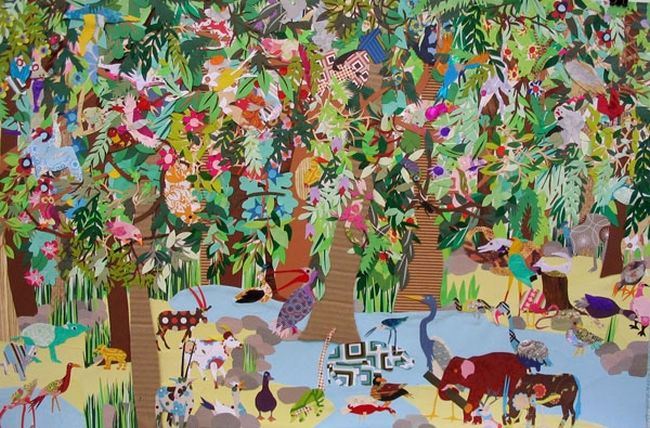
Fragile papercut jungle scene by Tanja K. Jensen. Tanja K. Jensen: Jungle II
Do you like to invite people into your home to see your collection?
I do enjoy showing it to people, but I mainly buy art for my own pleasure. No matter where I am in my home, I can look at art. I really like that. And then there's the fact that I've gotten to know a lot of the artists in person. It gives a great feeling to look at the works of these people that I know and respect. It's like a permanent dinner party. All my friends are gathered.
So the pieces remind you of the people, and it feels like they're there with you?
Yes.
That's beautiful. Actually, one thing I've been wondering about collecting is: why do you need to have original art? I have a lot of art posters at my place, and a great collection of picture files on my computer. That works alright for me.
I think something is lost when art is made into posters. Van Gogh's Starry Night is a great picture, but as a poster, it's just.... There's just something wrong. The paper is too glossy. But to me I think it's also about having an old-fashioned weakness for the hand-made. Almost everything in our lives is mass produced. Owning something which somebody has actually been greasing with their hands - that's interesting to me. It's a little less 'perfect' than a mass produced object. That also appeals to me. Hand-made objects bring a human touch with them.
It's not that I have anything against mass production. My life is full of computers and what not. But I think one thing I really like about original art is this human dimension.
What else does it do for you, having your home full of works of art?
It's all about looking at something beautiful and interesting. When I look around, I constantly create correspondances between one piece and another. Maybe it's the colours, maybe it's form or contents or something else. It's a very beautiful activity to me. And my brain rewards me for doing it. More or less consciously, I'm always thinking things like: "that green colour over there is related to that one over there", or "the orange in that painting opposes the blue in that one, and maybe that's what makes it so interesting to look at..." and so on. I'm always playing with my pieces.
You say your brain rewards you for this. How does that happen?
It's the same as if I'm researching something and I find an important connection. Then I also get this 'yay!'-feeling. A mental pat on the back. But when I'm looking at my pieces, it doesn't feel like work. It's a game. Most of my pieces are actually.... let me just check...
[At this point, Trine looks up and makes a contemplative expression. She's walking through her art collection in her mind. It seems like the art works that accompany her in her home are with her wherever she goes. - JSØ]
...most of my pieces are figurative in some way, she continues, They have something for the eye to roam around in. Maybe not a narrative as such, but a combination of details, totality and subtle connections to look for. I enjoy that very much.
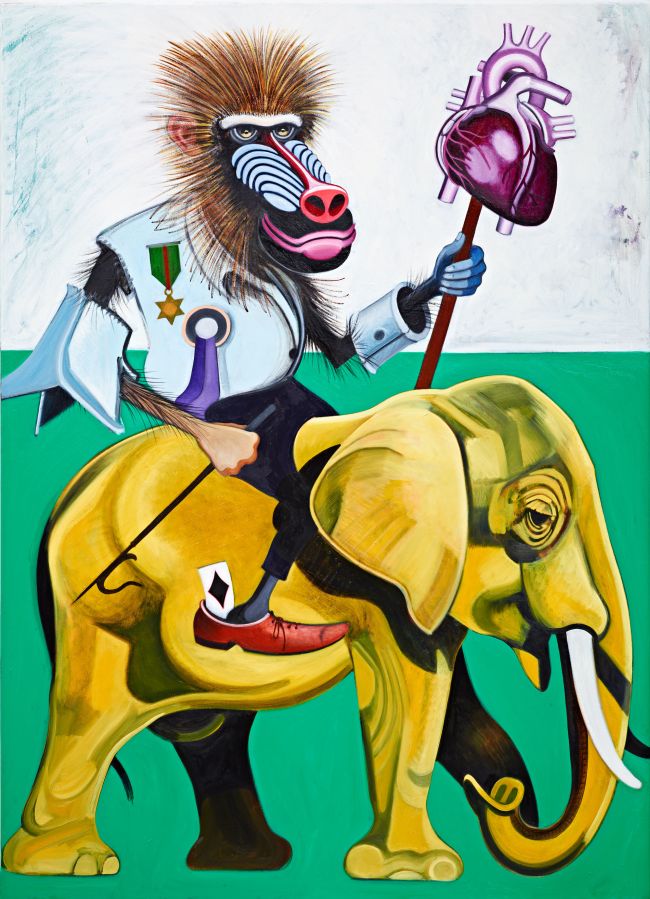
Lars Nørgård: Big White Monochrome, 2013. Lars Nørgård is an old acquaintance of Trine's and his art is the subject of one of her books. Two of his works adorn Trine's walls. This makes Nørgård one of the guests at Trine's permanent dinner party...
All in all, I gather that the pieces in your collection interact very much with each other...
Yes, and that's endlessly intriguing, but sometimes it's a pain in the arse, when you bring home a new piece, because it changes everything. It's only when you bring the new piece in that you find out if it's going to lift the others or if it's impossible to fit in. I find that really intriguing. Everything hangs very close on our walls, so all the pieces interact with each other. Sometimes a new piece can re-activate everything around it.
Do you consider this when you go out and buy the pieces - whether they will fit in with the rest?
No. We buy each piece for its own merits, and we just hope it will fit in.
So you're buying "with your heart", so to speak? Is it a feeling?
Yes. Well, with the heart and with the wallet.
Do you sometimes feel like you're also an artist yourself when you take new pieces home and contextualize them and make them interact with each other?
Yeah, we do play around a lot.
You make collage art?
Yes, [laughs]. Actually, our 3D objects are very well suited for this. They're easier to move than pictures, because pictures leave holes in the walls and such. With the sculptures, we're quite forward. They go inbetween the pot plants, up and down, anywhere. You can make entire narratives that way.
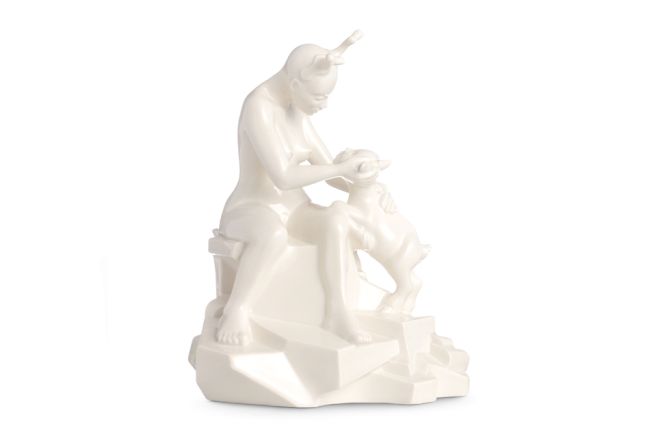
Louise Hindsgavl: Tenderness. From Trine's collection. Sculpture highly convenient for interior design experimentation
You have a lot of sculptures and other 3D objects in your collection?
Yes. Anything's cheaper than paintings, you know. Have you heard of Søren Behncke? He's a street artist of sorts, based in Aarhus. I have this piece of his, which is an angle grinder, made of cardboard, and pink. It's quite strange, and it's a great "ambassador". The first time my electrician saw it, he lit right up. He walked straight over to it and said "If that isn't an angle grinder....", even though it was pink and made of cardboard. It was the joy of recognition.
I think the most interesting development in contemporary art right now, at least in Denmark, is that the young artists are using so many new materials. It's been fun to witness the revival of ceramic, which used to be a 'hobby' material. Someone like Rose Eken has these trippy projects where she'll make anything in ceramic. She's very interested in music, so she makes records, guitars, and then these, Marshall.... is that right?
Marshall amplifiers?
Yes, that's it. And everything is full size, except that it shrinks ten percent when it dries. It's an utterly mad project. I mean, amplifiers?!
...and ceramic is just one material. People draw, embroider, use papier-machier... A whole world of new materials has opened. I find that very intriguing.
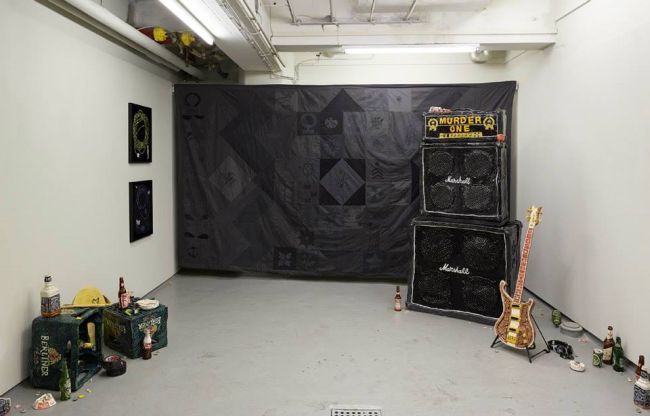
Rose Eken: MURDER ONE; Marshall amp, bass guitar, Black Quilt, tinsel paintings, ceramic crates and mess, V1 Gallery 2013. Photo: Jan Søndergaard
What else do you consider to be the most interesting developments in contemporary art at the moment?
It's fun to see how art is getting more and more international because people travel in a whole new way. If you're European, you can travel nearly anywhere at a reasonable price. And then there's the internet. There's a much greater exchange between styles now. That's interesting to me. The artists have to navigate in this international space and partake in a constant international dialogue but still maintain their own identity. It used to be difficult to determine when a work of art was made because sometimes, people would paint in a style that appeared 20 years earlier. Cubism in the 50's, and such. It's not like that anymore. It goes a lot faster now. This change of pace has affected art audiences as well as artists. If you do something that's already been done, the audience will call you out on it.
Do you find that today's young artist are more in touch with the reality we live in, or is that too much to say?
Well, they display a certain joy at telling a story. A joy at using colours, too. The 80's artists were in opposition to something, rather. They created good museum pieces, which might be a bit too heavy to have around you in your everyday. Today's young artists are less angry, really.
Is it important for you to be supporting these young artists by buying their art?
Well, I don't have a lot of money to support them with. Of course if we won the lottery...
If you won the lottery, would you spend a substantial amount of the money supporting upcoming artists?
Yes, definitely. My husband and I have lengthy discussions about that. As it is now, it doesn't make much of an economic difference to the artists if I buy their works. But maybe in other ways. Some artists actually give me pieces for free because they believe that will further their careers.
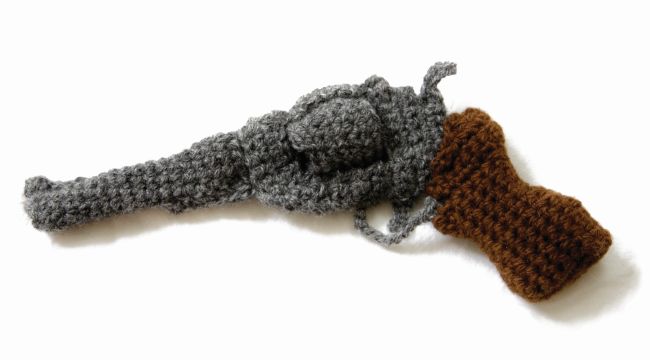
Hanne G: Six Shooter. A wool gun. What Trine is talking about when she says contemporary artists are not shy when it comes to choice of materials
I think if you support someone right at the beginning, you can earn yourself a lifelong friend. Artists probably never forget the first person who bought one of their pieces. That really makes a great impression.
[Now the sun creeps into the frame of the window and flares right in my eyes. Instead of squinting, I suggest we move a little to the left to escape the rays. As we drag ourselves back into the shade, I suddenly start hearing the noises around me again, and I realize that we've already been talking for an hour and that the family sitting next to us is eavesdropping intently. I sense that our moment is passing and begin to ask her about the future. - JSØ]
I understand that your walls are already full. So what happens next time you buy art?
That's a really good question. I'll never sell anything, of course...
Nothing, ever?
Not as long as I'm alive. I could never sell them. They're my friends. With some of them, I can't even imagine that I once didn't have them. It's the same as with my nephew and my niece. It's incredible to think that they once weren't there.
I also feel like I don't truly own my pieces. I'm just keeping them. I'm their guardian. They're living with me for a while, and then they will move on. Not while I'm alive, though! But I believe good art reaches beyond the individual. Beyond the the artist as well as the owner. It's something that more people should share in. It can't truly be owned.
But to answer your question: I really don't know. I've lent some pieces to my sister to free up some wall space, but that's not going to last.
Are you going to lower your buying rate then?
No, I don't think so. When I buy art, I don't consider all these practical questions - except whether I can afford it. So I really don't know where it's going to go from here.